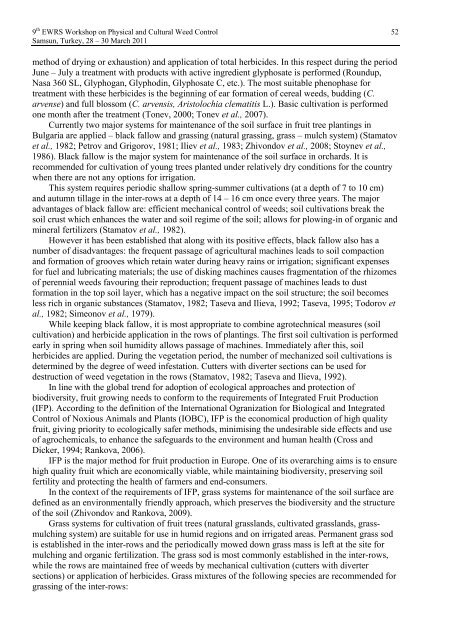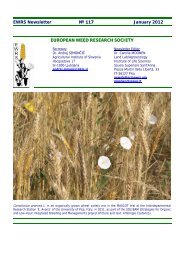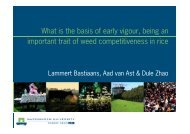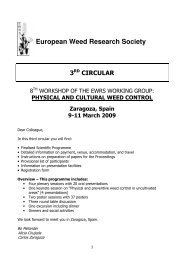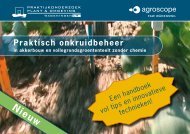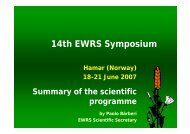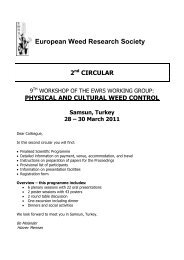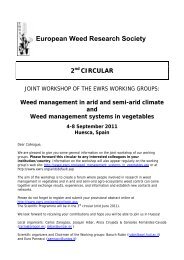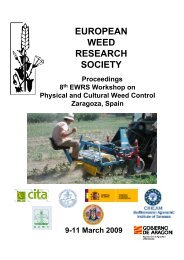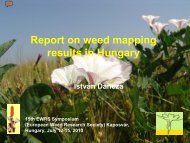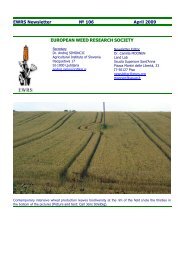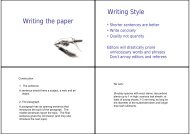Physical and Cultural Weed Control Working Group of - European ...
Physical and Cultural Weed Control Working Group of - European ...
Physical and Cultural Weed Control Working Group of - European ...
Create successful ePaper yourself
Turn your PDF publications into a flip-book with our unique Google optimized e-Paper software.
9 th EWRS Workshop on <strong>Physical</strong> <strong>and</strong> <strong>Cultural</strong> <strong>Weed</strong> <strong>Control</strong> 52<br />
Samsun, Turkey, 28 – 30 March 2011<br />
method <strong>of</strong> drying or exhaustion) <strong>and</strong> application <strong>of</strong> total herbicides. In this respect during the period<br />
June – July a treatment with products with active ingredient glyphosate is performed (Roundup,<br />
Nasa 360 SL, Glyphogan, Glyphodin, Glyphosate C, etc.). The most suitable phenophase for<br />
treatment with these herbicides is the beginning <strong>of</strong> ear formation <strong>of</strong> cereal weeds, budding (C.<br />
arvense) <strong>and</strong> full blossom (C. arvensis, Aristolochia clematitis L.). Basic cultivation is performed<br />
one month after the treatment (Tonev, 2000; Tonev et al., 2007).<br />
Currently two major systems for maintenance <strong>of</strong> the soil surface in fruit tree plantings in<br />
Bulgaria are applied – black fallow <strong>and</strong> grassing (natural grassing, grass – mulch system) (Stamatov<br />
et al., 1982; Petrov <strong>and</strong> Grigorov, 1981; Iliev et al., 1983; Zhivondov et al., 2008; Stoynev et al.,<br />
1986). Black fallow is the major system for maintenance <strong>of</strong> the soil surface in orchards. It is<br />
recommended for cultivation <strong>of</strong> young trees planted under relatively dry conditions for the country<br />
when there are not any options for irrigation.<br />
This system requires periodic shallow spring-summer cultivations (at a depth <strong>of</strong> 7 to 10 cm)<br />
<strong>and</strong> autumn tillage in the inter-rows at a depth <strong>of</strong> 14 – 16 cm once every three years. The major<br />
advantages <strong>of</strong> black fallow are: efficient mechanical control <strong>of</strong> weeds; soil cultivations break the<br />
soil crust which enhances the water <strong>and</strong> soil regime <strong>of</strong> the soil; allows for plowing-in <strong>of</strong> organic <strong>and</strong><br />
mineral fertilizers (Stamatov et al., 1982).<br />
However it has been established that along with its positive effects, black fallow also has a<br />
number <strong>of</strong> disadvantages: the frequent passage <strong>of</strong> agricultural machines leads to soil compaction<br />
<strong>and</strong> formation <strong>of</strong> grooves which retain water during heavy rains or irrigation; significant expenses<br />
for fuel <strong>and</strong> lubricating materials; the use <strong>of</strong> disking machines causes fragmentation <strong>of</strong> the rhizomes<br />
<strong>of</strong> perennial weeds favouring their reproduction; frequent passage <strong>of</strong> machines leads to dust<br />
formation in the top soil layer, which has a negative impact on the soil structure; the soil becomes<br />
less rich in organic substances (Stamatov, 1982; Taseva <strong>and</strong> Ilieva, 1992; Taseva, 1995; Todorov et<br />
al., 1982; Simeonov et al., 1979).<br />
While keeping black fallow, it is most appropriate to combine agrotechnical measures (soil<br />
cultivation) <strong>and</strong> herbicide application in the rows <strong>of</strong> plantings. The first soil cultivation is performed<br />
early in spring when soil humidity allows passage <strong>of</strong> machines. Immediately after this, soil<br />
herbicides are applied. During the vegetation period, the number <strong>of</strong> mechanized soil cultivations is<br />
determined by the degree <strong>of</strong> weed infestation. Cutters with diverter sections can be used for<br />
destruction <strong>of</strong> weed vegetation in the rows (Stamatov, 1982; Taseva <strong>and</strong> Ilieva, 1992).<br />
In line with the global trend for adoption <strong>of</strong> ecological approaches <strong>and</strong> protection <strong>of</strong><br />
biodiversity, fruit growing needs to conform to the requirements <strong>of</strong> Integrated Fruit Production<br />
(IFP). According to the definition <strong>of</strong> the International Ogranization for Biological <strong>and</strong> Integrated<br />
<strong>Control</strong> <strong>of</strong> Noxious Animals <strong>and</strong> Plants (IOBC), IFP is the economical production <strong>of</strong> high quality<br />
fruit, giving priority to ecologically safer methods, minimising the undesirable side effects <strong>and</strong> use<br />
<strong>of</strong> agrochemicals, to enhance the safeguards to the environment <strong>and</strong> human health (Cross <strong>and</strong><br />
Dicker, 1994; Rankova, 2006).<br />
IFP is the major method for fruit production in Europe. One <strong>of</strong> its overarching aims is to ensure<br />
high quality fruit which are economically viable, while maintaining biodiversity, preserving soil<br />
fertility <strong>and</strong> protecting the health <strong>of</strong> farmers <strong>and</strong> end-consumers.<br />
In the context <strong>of</strong> the requirements <strong>of</strong> IFP, grass systems for maintenance <strong>of</strong> the soil surface are<br />
defined as an environmentally friendly approach, which preserves the biodiversity <strong>and</strong> the structure<br />
<strong>of</strong> the soil (Zhivondov <strong>and</strong> Rankova, 2009).<br />
Grass systems for cultivation <strong>of</strong> fruit trees (natural grassl<strong>and</strong>s, cultivated grassl<strong>and</strong>s, grassmulching<br />
system) are suitable for use in humid regions <strong>and</strong> on irrigated areas. Permanent grass sod<br />
is established in the inter-rows <strong>and</strong> the periodically mowed down grass mass is left at the site for<br />
mulching <strong>and</strong> organic fertilization. The grass sod is most commonly established in the inter-rows,<br />
while the rows are maintained free <strong>of</strong> weeds by mechanical cultivation (cutters with diverter<br />
sections) or application <strong>of</strong> herbicides. Grass mixtures <strong>of</strong> the following species are recommended for<br />
grassing <strong>of</strong> the inter-rows:


